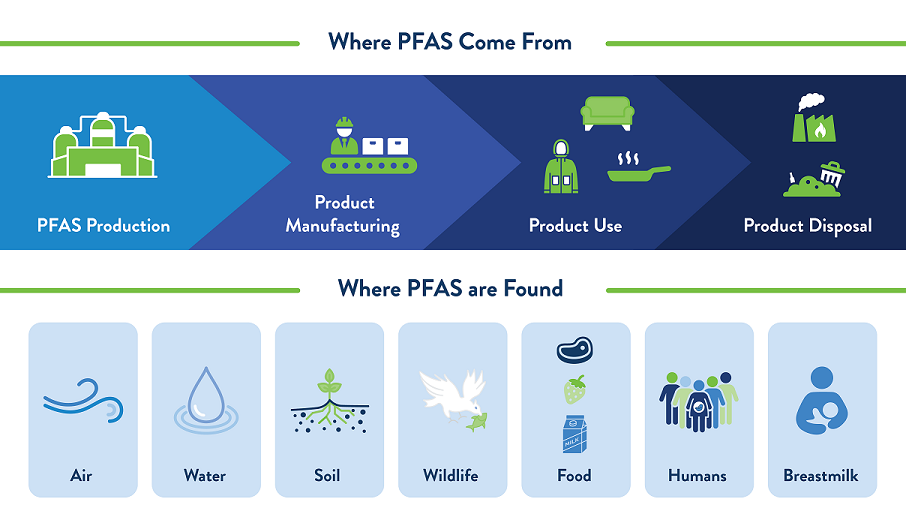Per- and Polyfluoroalkyl Substances (PFAS)
Related Topics
- Drinking Water
- Water Contaminants and Your Health
- Special Well and Boring Construction Areas
- Wells and Borings
- MDH Guidance
- Air Quality by Topic
Environmental Health Division
Contact Info
Per- and Polyfluoroalkyl Substances (PFAS)
Information about PFAS well testing and filtration systems in the Twin Cities East Metro: Visit the Minnesota Pollution Control Agency (MPCA) on the web at Well sampling in the east metro or contact the Minnesota Pollution Control Agency East Metro Unit by email at PFAS.Well.Sampling.MPCA@state.mn.us.
PFAS are a family of human-made chemicals that have been widely used for decades. PFAS are commonly used for their water- and grease-resistant properties. PFAS are extremely stable and do not breakdown in the environment. They have been found in the groundwater and surface water in Minnesota. Some PFAS can build up and stay in the human body for many years. They can also slowly decline if the exposure stops.
Our understanding and ability to detect PFAS in the environment has evolved since the Minnesota Pollution Control Agency (MPCA) and the Minnesota Department of Health (MDH) began investigating them in 2002. We consider PFAS emerging contaminants. Emerging contaminants are contaminants about which we have a new awareness or understanding about how they move in the environment or affect public health. PFAS, like other emerging contaminants, are the focus of active research and study, which means that new information is released frequently.
- Drinking water is just one way people are exposed to PFAS. To reduce the potential health risks from PFAS for all Minnesotans, drinking water can be treated, and non-water sources must be addressed. At very low levels of PFAS in water, lowering exposure to PFAS from other sources becomes more important for public health.
- MDH scientists recently published an analysis demonstrating that, for most people, the majority of PFOA in their blood is from non-water sources: Estimation of Serum PFOA Concentrations from Drinking and Non–Drinking Water Exposures.
Minnesota is undertaking PFAS pollution prevention measures including a new law known as Amara’s Law that prohibits avoidable use of PFAS use in Minnesota by 2032. Prohibitions on PFAS in certain categories of products begin next year.
Minnesotans can take simple actions now to reduce exposure. More information can be found at Reducing Exposures: Per- and Polyfluoroalkyl substances (PFAS) (PDF).

MDH PFAS information
PFAS and Health
Information about health risks of exposure to PFAS, health-based guidance for PFAS in water and air, and how to lower your exposure to PFAS.
PFAS and Products
Information about PFAS exposure through consumer products, and how to your lower exposure.
PFAS Resources for Health Care Providers
For use by health care providers in counseling patients.
MDH Cancer Reporting System (MCRS) Reports
Reports for communities using data reported to MCRS.
PFAS Biomonitoring for Minnesota Firefighters
PFAS biomonitoring for Minnesotan Firefighters best practice report, biomonitoring project and resources.
MDH PFAS Biomonitoring: East Metro
Blood levels of PFAS tested over time in people from the St. Paul East Metro area.
PFAS and Private Wells
Information on testing your private well.
PFAS Sites in Minnesota
The Minnesota Department of Health (MDH) and Minnesota Pollution Control Agency (MPCA) have investigated a number sites across the state where PFAS were released to the environment.
Stress at Contaminated Sites: Coping with the stress that environmental contamination can cause (PDF)
PFAS and Fish
Advice about eating fish from lakes and rivers where fish have been tested and contaminant levels in some fish species are higher.
PFAS Testing of Public Water Systems
About PFAS testing in drinking water from public water systems.
PFAS and Home Treatment of Water
If you have concerns about your health, you can take steps to reduce your potential exposure to PFAS from drinking water in your home.
PFAS and Homegrown Garden Produce (PDF)
Watering home gardens with PFAS‐contaminated water can increase the levels of PFAS in the soil and edible plants.
PFAS and Home-raised Farm Animals
Offering PFAS-contaminated water to farm animals could lead to the build-up of certain PFAS in animal tissue. This information came from a collaboration with the Minnesota Pollution Control Agency (MPCA) and the Minnesota Department of Agriculture (MDA)and is hosted on the MDA website.
History of PFAS
Since 2002, the MDH has partnered with other state agencies to protect the environment and health of people in Minnesota. MDH PFAS activities through the years are listed here.
Other agency resources
- Minnesota Pollution Control Agency: PFAS pollution
- Minnesota Pollution Control Agency: Minnesota’s PFAS Blueprint
- US Environmental Protection Agency: Research on Per- and Polyfluoroalkyl Substances (PFAS)
- US Environmental Protection Agency: PFAS Explained
- Agency for Toxic Substances and Disease Registry: Per- and Polyfluoroalkyl Substances (PFAS) and Your Health
Go to top